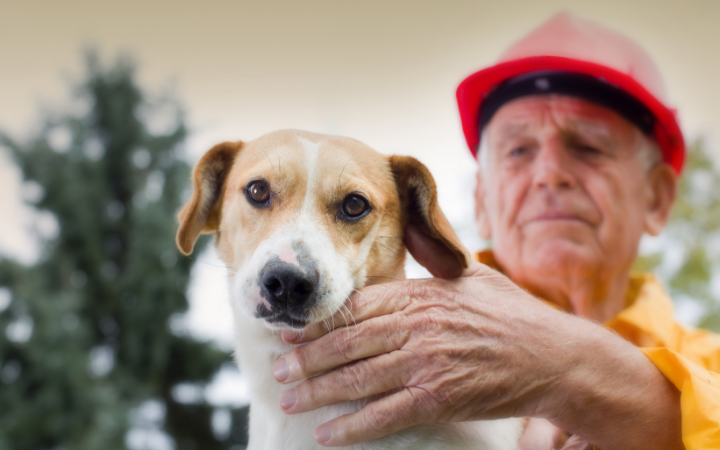A disaster can be tough on people and often tougher on pets, whether they are natural disasters or made-made. With a little advanced planning, you can keep the four-legged members of your family safe and sound.
Before the evacuation order is issued
Secure pet identification. Make sure that all dogs and cats have a collar with ID tags attached. For a more enduring solution, have your pet microchipped for permanent identification.
Verify that your current emergency phone and cell phone numbers are listed on the ID tag or registered with the microchip-monitoring agency. If you adopted your pet and he was already chipped, you can transfer his microchip registration to your name by providing his adoption contract.
Vaccinate and spay/neuter. In an emergency your pet may need to be housed with other animals in crowded conditions. Most shelters that accept pets require that they are up-to-date on all vaccinations.
If you have not already done so, spay or neuter your pet. Fixing your dog or cat is not only vital to her long-term health and to reducing pet overpopulation – many emergency shelters and boarding facilities require that animals be fixed.
Proof of ownership. If you become separated from your pet you will be required to show proof of ownership to re-claim her when the evacuation is over. Keep a copy of your pet’s license registration, vaccination record or similar documentation with you.
To help prove ownership, keep a picture of you and your pet together that highlights her identifying characteristics.
Medical records. If you have a dog or cat with special needs or a medical condition, get copies of relevant medical records from your veterinarian – particularly prescriptions – to give to a temporary caretaker. Keep all current medications and records in an easily accessible, waterproof container or bag.
Evacuation plan. Where will you go with your pet when disaster strikes? American Red Cross shelters do not allow animals except for certified service dogs. Check beforehand whether friends, family, veterinarians or kennels outside your area will temporarily house your pet.
You can find pet-friendly hotels on the internet at PetTravelCenter.com or Pet Friendly Hotels. Ask your local animal control agency where dogs and cats can be housed safely during an evacuation. Check out planning tips from the Federal Emergency Management Agency, FEMA, to prepare your pets for the unexpected.
Contingency plan. Let your landlord or trusted neighbors know that you have a pet and ask if they will help care for him if you are not home when a disaster strikes. Leave emergency contact and cell phone numbers for the caretaker, as well as any necessary food, supplies, medication, and special instructions for your pet’s care.
Consider posting an emergency decal on the front window or door of your home to alert any first responders that an animal may be inside.
Practice beforehand. In an emergency, you may have to temporarily confine your pet in a crate or carrier. If your pet is not used to such confinement, practice placing your pet in the crate or carrier a few times each month so that he will cooperate in an emergency.
Create a pet emergency kit
Whether you must evacuate or choose to stay at home, make sure that you have two weeks’ worth of supplies to sustain your pet. Your emergency supply kit should include:
Food and water. Two weeks’ of your pet’s food. For canned food, purchase single-serving pop-top cans in case refrigeration is not available during or after the disaster. Place kibble in an airtight container or watertight bag so that it does not get wet and spoil.
Feeding bowls and cleaning supplies. Pack collapsible or disposable bowls, as well as dish soap and towels for cleaning.
Medication. At least two weeks’ supply of prescription medications and preventatives (e.g., flea, heartworm).
Sanitation. Two weeks’ worth of kitty litter and a scoop, or poop bags and a pooper scooper. Include disposable gloves, rags or towels, and disinfectant to clean out your pet’s crate or kennel.
Comfort. Do not forget bedding, blankets and toys. These familiar, comfort items will help ease your pet’s anxiety when she is housed in an unfamiliar environment.
Safety. Collar, leash, muzzle, stake out, etc., as applicable.
Pet first-aid kit. Bandages of assorted sizes, cotton swabs, antiseptic, first-aid cream, tweezers and small scissors.
Staying safe
Always bring your pets indoors or into an otherwise safe place during extreme weather of any kind.
If you have multiple pets, you may need to separate them temporarily if they become reactive under stress. When you return home, do not let your pet into the yard until you have inspected it for loose or falling debris.
Be prepared
While a natural disaster is a stressful event for humans and animals alike, you can increase your pet’s chance for survival with some basic preparation.












What if there are no local places to safely leave the pet? Everyone will be concerned w/the human safety-thank goodness!!!, but I couldn’t handle going off & leaving my little one-we are all each of us has. I’d have to live in my car first-not sure how safe that would be for either of us.
Why can’t every shelter have an area for those of us w/pets so we can all stay together and reduce that stress on all of us?
Our pups and cats are the leaders, by example, of how humanity should behave. When planning, always include the family leader (read as pet). Great information included in the plan!
You’re absolutely right about pets setting a great example for us, John. Thanks for sharing and for your kind words.
I use Pet ID tags for my dog. We have a friendly neighborhood, and in case my pet lost i am sure my pet will return home. I heard micro chipping is also a great choice for dog safety .Thanks for this great blog
It would be awesome if you could make this a printable version.